Kevin Aho - Existentialism - An Introduction
Здесь есть возможность читать онлайн «Kevin Aho - Existentialism - An Introduction» весь текст электронной книги совершенно бесплатно (целиком полную версию без сокращений). В некоторых случаях можно слушать аудио, скачать через торрент в формате fb2 и присутствует краткое содержание. Год выпуска: 2013, ISBN: 2013, Издательство: Polity, Жанр: Философия, на английском языке. Описание произведения, (предисловие) а так же отзывы посетителей доступны на портале библиотеки ЛибКат.
- Название:Existentialism: An Introduction
- Автор:
- Издательство:Polity
- Жанр:
- Год:2013
- ISBN:978-0745651422
- Рейтинг книги:3 / 5. Голосов: 1
-
Избранное:Добавить в избранное
- Отзывы:
-
Ваша оценка:
- 60
- 1
- 2
- 3
- 4
- 5
Existentialism: An Introduction: краткое содержание, описание и аннотация
Предлагаем к чтению аннотацию, описание, краткое содержание или предисловие (зависит от того, что написал сам автор книги «Existentialism: An Introduction»). Если вы не нашли необходимую информацию о книге — напишите в комментариях, мы постараемся отыскать её.
Existentialism: An Introduction
Existentialism: An Introduction — читать онлайн бесплатно полную книгу (весь текст) целиком
Ниже представлен текст книги, разбитый по страницам. Система сохранения места последней прочитанной страницы, позволяет с удобством читать онлайн бесплатно книгу «Existentialism: An Introduction», без необходимости каждый раз заново искать на чём Вы остановились. Поставьте закладку, и сможете в любой момент перейти на страницу, на которой закончили чтение.
Интервал:
Закладка:
But if intellectual detachment results in an emotionally desiccated and bleached-out view of the world, the insider's perspective presents its own problems. Specifically, if we are embedded in a world of meanings that invariably distorts and colors our view of things in ways that we are not explicitly aware, then how can we ever be true to ourselves and commit to an identity that is genuinely our own? In order to address this question, we have to first get a clearer sense of the ways in which existentialists contend that we are bound up in the world. In the next chapter we will explore a number of influential accounts of being-in-the-world and show how they not only undermine the view of the philosopher as a detached spectator but also challenge a number of entrenched dualisms that have been central to Western thought.
Cooper, D. (2012). Existentialism as a philosophical movement . In S. Crowell (ed.), The Cambridge companion to existentialism (pp. 27–49). New York: Cambridge University Press.
Joseph, F. and J. Reynolds (2011). Existentialism, phenomenology and philosophical method . In F. Joseph, J. Reynolds, and A. Woodward (eds.), The Continuum companion to existentialism (pp. 15–35). London: Continuum.
Moran, D. (2000). Introduction to phenomenology . New York: Routledge.
Richardson, J. (1986). Existential epistemology: A Heideggerian critique of the Cartesian project . Oxford: Clarendon Press.
3: Being-in-the-World
Being-in
Again, existentialists reject the standpoint of detachment and objectivity because it invariably overlooks the situated needs and commitments that matter to me as an individual. As Kierkegaard writes, “What would be the use of discovering so-called objective truth, of working through all the systems of philosophy … to construct a world in which I do not live but only hold it up for the view of others?” (1959, 78). The aim of rational detachment is to achieve the ‘perspective of eternity,’ but this results in the abandonment of the concrete meanings that shape our lives. To address this problem, existentialists often begin their projects with accounts of life as it is lived in ordinary contexts. What is revealed in these accounts is that we are already ‘being-in,’ that is, embedded and involved in a shared world. Understood this way, being-in is not a reference of spatial inclusion, of an object or thing that is inside a container (e.g., ‘The chicken is in the pot’). It is a reference to how we are concretely involved in the world in a particular way (e.g., ‘The professor is in class’). The latter example refers to how one is engaged in the practices of the academic world that constitute what it means to be a professor — lecturing to students, grading papers, holding office hours, replying to emails, etc. (see Dreyfus 1991, 40–43). ‘Being-in,’ then, is not an accidental property that we may or may not have; it is essential to and constitutive of what it means to be human. And ‘world’ is not to be understood in the usual sense as a spatial container or the sum total of objects. The world, rather, is that “ wherein [we] live” (Heidegger 1962, 83). It is the meaningful public setting of our lives.
Insofar as it is constitutive of human existence, ‘being-in’ suggests that we are not disinterested minds looking down on the world. We are already caught up in a concrete situation as we handle various tools, try to accomplish certain tasks, and engage in the lives of others. This not only means that we encounter things from a limited physical perspective and orientation; it also implies that we are always woven into the meanings and values of our sociohistorical context, and this shapes the way we make sense of things, including ourselves. Interpreting existence from this standpoint allows existentialists to dismantle a number of dualisms that have dominated the Western philosophical tradition. To illustrate this, we can turn to the work of Heidegger and Merleau-Ponty, who offer the most robust and influential accounts of being-in-the-world.
Undoing dualisms
By giving primacy to being-in-the-world, existentialists challenge the subject-object model that characterizes much of modern philosophy. This model, expressed most famously in the work of Descartes, regards humans as self-contained subjects of experience trapped in their own minds and who are trying to discover whether or not their ‘inner’ perceptions and ideas accurately represent ‘outer’ objects in the world. This representational view creates skepticism or doubt about whether or not anything in the world — that is, outside the ‘I’ or consciousness — can be known with any certainty. The result is an explicit separation between mental and physical phenomena and creates two competing accounts in the modern epistemological tradition, ‘realism’ and ‘idealism.’ On the realist view, the world and material things are said to exist externally or independently of our minds; on the idealist view, the only things we know that exist are the ideas in our own minds. Underlying these two accounts is the problem of proving the existence of a mind-independent world if the only thing we can claim to know with any certainly is the contents of our own mind. After all, how could I possibly doubt that I perceive, desire, or feel something? The problem is whether or not what I perceive, desire, or feel actually represents or corresponds to things that exist in the world. In his Critique of Pure Reason (1787), Immanuel Kant (1724–1804) will famously refer to the fact that modern philosophers have still not proven whether or not an external world exists as a ‘scandal.’ Existentialists will go further than Kant by arguing that the whole ‘inner/outer’ question is nothing more than a tired pseudo-problem that has bogged down philosophers for three hundred years. As Heidegger says, what is truly “scandalous” is not that philosophers have failed to adequately demonstrate the existence of an external or mind-independent world, “but that such proofs are expected and attempted again and again ” (1962, 249).
Existentialists reject both realist and idealist accounts by arguing that in our ordinary experiences there is no separation between ‘inner’ and ‘outer,’ between self and world. On their view, these accounts distort the fact that we are, first and foremost, “already out there,” already engaged in the world and “opened toward beings” (Heidegger 1992, 167). Indeed, interpreting existence in terms of being-in-the-world suggests that the debate between realism and idealism is not even worthy of philosophical consideration (e.g., Guignon 1983). This is because the whole problem is based on an error that assumes human beings are basically self-enclosed minds who are trying to get clear about their beliefs of mind-independent objects. Against this view, existentialists argue that we are already enmeshed in the world in our everyday practices and that we already understand things in terms of their practical uses and purposes. I do not, for instance, first stare at the computer and reflect on its objective properties before I use it. As a professor involved in the acts and practices of the academic world, I already inhabit an understanding of the computer in terms of its practical function and use. My hands simply begin to press the keys, with my eyes leveled at the screen and my elbows resting on the desk. This kind of oriented and purposive activity is performed pre-reflectively, without the accompaniment of mental representation.
Interpreting existence in terms of situated understanding also allows existentialists to challenge the ‘fact — value’ dualism central to modern philosophy. On this view, there is a fundamental distinction drawn between what is objective or real in the physical universe versus what is subjective or existing only in our own minds. The aim of the philosopher or scientist is to bracket out ‘values,’ that is, the subjective colorings that we impose on things based on our own idiosyncratic tastes, cultural backgrounds, and sensory apparatuses in order to discover mind-independent ‘facts.’ What is factual or true, as we saw earlier, is usually interpreted in terms of what is quantifiable, pertaining to the measurable qualities of mass, weight, movement, and spatial-temporal location. The upshot of the fact-value dichotomy is that there can be no such thing as a ‘moral fact’ and that the meaning, significance, and purpose of things comes to be regarded as merely subjective or a sociocultural projection rather than qualities that adhere to the things themselves. Existentialists reject this picture by arguing that in our everyday dealings we never encounter quantifiable objects in isolation. Rather, the things we encounter are already bound up in contexts of meaning, and their significance is disclosed not through inner acts of consciousness but through our purposive involvements within this context. “[We] do not, so to speak, throw a ‘signification’ over some naked thing which is present-at-hand,” says Heidegger, “we do not stick a value on it; but when something within-the-world is encountered as such, the thing in question already has an involvement which is disclosed in our understanding of the world” (1962, 190–191).
Читать дальшеИнтервал:
Закладка:
Похожие книги на «Existentialism: An Introduction»
Представляем Вашему вниманию похожие книги на «Existentialism: An Introduction» списком для выбора. Мы отобрали схожую по названию и смыслу литературу в надежде предоставить читателям больше вариантов отыскать новые, интересные, ещё непрочитанные произведения.
Обсуждение, отзывы о книге «Existentialism: An Introduction» и просто собственные мнения читателей. Оставьте ваши комментарии, напишите, что Вы думаете о произведении, его смысле или главных героях. Укажите что конкретно понравилось, а что нет, и почему Вы так считаете.












